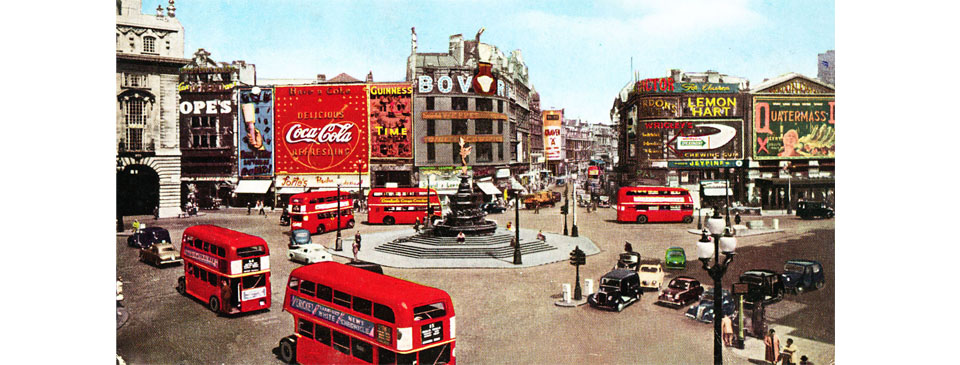In brief – Late-20th century London

Traffic flows around the Shaftesbury Memorial fountain at Piccadilly Circus in about 1955. The Bovril and Guinness advertisements had been in place for several decades when they were joined by Coca Cola shortly before this photo was taken. The film Quatermass Experiment is showing at the London Pavilion cinema.
Throughout the century there was a growing interest in London’s history. The Second World War, subsequent redevelopment, and modernisation had destroyed many buildings and other landmarks, increasing peoples’ wish to preserve what remained of historical or architectural significance. A watershed came in 1962 with the destruction of the Euston Arch entrance when the station was redeveloped, as well as the Coal Exchange on Lower Thames Street. Thereafter conservationists became more vigilant and better-organised in their efforts to preserve the capital’s heritage. The destruction of much of central London during the war unearthed much of the previously-hidden past. As old buildings were demolished thereafter archaeologists discovered further sections of old London.
From the 1970s London, home to both a large Jewish community and many Arabic political exiles, became an occasional battleground for Middle Eastern assassins, with a number of political killings taking place in the capital. In April 1980 six Iraqi-backed Khuzestan-Iranians, seeking independence for their province, occupied the Iranian embassy. The five-day siege was brought to an end by the SAS. A female police constable was shot dead in April 1984 when a staff member of the Libyan People’s Bureau in St. James’s Square fired at a demonstration taking place outside.
From the beginning of the 1970s the Provisional IRA began a campaign of bombings and assassinations in England, the majority taking place in London. In October 1971 a bomb exploded on the thirty-third floor of what was then called the Post Office Tower in the West End. The campaign of bombings and assassinations continued in London, causing numerous deaths and damage to property. On many occasions parts of London were evacuated and sealed off as bomb-disposal experts searched for real or threatened devices. The Provisional IRA’s campaign continued until July 1997, although other Republican splinter groups continued planting bombs until 2001.
Prior to the Second World War the inflexible tram network began to be replaced by electric trolleybuses. They in turn were replaced by diesel-powered buses by 1962. There were no significant changes to London’s underground network between 1948 and 1968 when the Victoria line was opened. Thereafter the Piccadilly line was extended to Heathrow in 1977 and the Fleet line created (later extended and renamed the Jubilee line). However, the under-funded underground network was beginning to show its age and became increasingly unreliable as time went on. As the docks were redeveloped the new Docklands Light Railway was created in East London using driverless trains, operating from 1987. The first Eurostar trains to the Continent via the Channel Tunnel ran in 1994, initially with Waterloo as the London terminus.
Traffic congestion, which had been previously restricted to the City, spread outwards and, from the 1950s, bottlenecks began to occur throughout the metropolis. After the war the creation of new roads and junctions became a priority for the planners at the LCC. When the GLC was formed in 1965 they unveiled plans for a series of new ring-roads, including an extension of the North and South Circular Roads. However the initiatives came to a halt after protests that followed the completion of the elevated Westway motorway from Paddington to White City in July 1970. In the latter part of the century London’s authorities instead concentrated on improving public transport.
